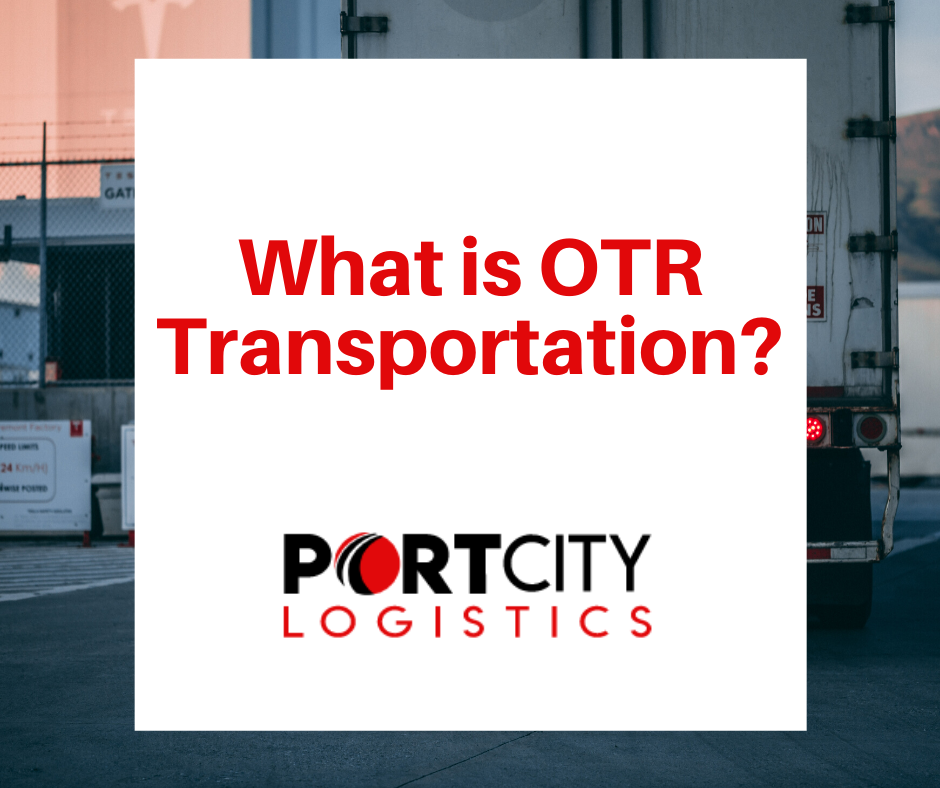When it comes to logistics and supply chain management, OTR transportation carriers play a vital role in moving goods across the country. Imagine a truck traveling thousands of miles, carrying essential products that keep our economy running smoothly. That’s exactly what OTR transportation is all about! If you’ve ever wondered how goods make their way from manufacturers to retailers, this is your chance to dive deep into the world of over-the-road shipping. So, buckle up and let’s get started!
OTR transportation carriers are like the backbone of the shipping industry. They ensure that everything from food to furniture gets delivered on time, no matter how far the destination. But what exactly does it take to be an OTR carrier? And why is this type of transportation so important? In this guide, we’ll break it all down for you in simple terms, so you can understand the ins and outs of this crucial industry.
Before we dive deeper, let’s clear something up. OTR stands for Over-the-Road, and it refers specifically to long-haul trucking. Unlike local or regional deliveries, OTR carriers travel vast distances, often crossing state lines or even countries. This type of shipping requires a unique set of skills, equipment, and planning. So, if you’re curious about how it all works, keep reading!
Read also:Johnny Sins Profession The Untold Story Behind The Scenes
What Exactly is an OTR Transportation Carrier?
An OTR transportation carrier is a company or individual that specializes in moving goods over long distances using trucks. Think of it as the "long-distance runner" of the logistics world. These carriers are responsible for transporting everything from raw materials to finished products, ensuring they reach their destination safely and efficiently.
Now, here’s the kicker: OTR carriers aren’t just about driving trucks. They also handle logistics, route planning, and compliance with regulations. It’s a complex operation that requires attention to detail and a deep understanding of the industry. From fuel management to driver safety, every aspect of OTR transportation is carefully managed to ensure success.
Key Characteristics of OTR Carriers
Let’s take a closer look at what makes OTR carriers stand out:
- Long-Haul Capability: OTR carriers can travel thousands of miles in a single trip.
- Specialized Equipment: They use heavy-duty trucks and trailers designed for long-distance travel.
- Skilled Drivers: OTR drivers are highly trained professionals who can handle challenging routes and weather conditions.
- Regulatory Compliance: OTR carriers must adhere to strict rules and regulations, including hours-of-service limits and safety standards.
These characteristics make OTR transportation carriers an essential part of the global supply chain. Without them, many industries would struggle to meet consumer demand.
Why is OTR Transportation Important?
OTR transportation isn’t just about moving goods; it’s about keeping the economy moving. Think about it: every product you buy, from the clothes you wear to the electronics you use, likely traveled on an OTR truck at some point. This type of shipping is critical for industries that rely on just-in-time delivery, such as automotive, retail, and manufacturing.
Here’s a fun fact: OTR carriers transport approximately 70% of all freight in the United States. That’s a staggering amount of goods being moved every day! Without OTR transportation, businesses would face delays, increased costs, and potential shortages. It’s no wonder this industry is so vital to the global economy.
Read also:Big And Beautiful The Ultimate Guide To Bbw Massage
Benefits of Using OTR Carriers
There are several advantages to using OTR transportation carriers:
- Cost-Effective: OTR shipping is often more affordable than air or rail transport for large shipments.
- Flexibility: OTR carriers can adapt to changing routes and schedules, making them ideal for unpredictable supply chains.
- Reliability: With proper planning, OTR carriers can deliver goods on time, even over long distances.
- Scalability: OTR transportation can handle small or large shipments, depending on your needs.
These benefits make OTR transportation a popular choice for businesses of all sizes. Whether you’re shipping a single pallet or an entire truckload, OTR carriers can get the job done.
How OTR Transportation Works
So, how exactly does OTR transportation work? It’s a multi-step process that involves several key players, including carriers, drivers, and logistics providers. Here’s a breakdown of the typical OTR shipping process:
Step 1: Planning and Coordination
Before a truck hits the road, there’s a lot of planning involved. This includes:
- Route Optimization: Determining the most efficient route to the destination.
- Load Matching: Pairing available trucks with suitable loads.
- Compliance Checks: Ensuring all regulatory requirements are met.
These steps are crucial for ensuring a smooth and successful delivery.
Step 2: Loading and Dispatch
Once the planning is complete, it’s time to load the truck and hit the road. This involves:
- Inspecting the Vehicle: Ensuring the truck is in good condition and ready for a long journey.
- Securing the Load: Properly loading and securing cargo to prevent damage during transit.
- Driver Briefing: Providing drivers with all necessary information, including route details and safety protocols.
With everything in place, the truck is ready to roll!
Step 3: Delivery and Unloading
After the long journey, the final step is delivering the goods to their destination. This involves:
- Inspection: Checking the cargo for any damage or discrepancies.
- Unloading: Safely removing the goods from the truck.
- Documentation: Completing all necessary paperwork to confirm delivery.
And just like that, the OTR shipping process comes full circle!
Challenges Faced by OTR Transportation Carriers
While OTR transportation is incredibly important, it’s not without its challenges. Here are some of the biggest obstacles carriers face:
- Driver Shortage: There’s currently a shortage of qualified OTR drivers, which can impact delivery times and costs.
- Regulatory Changes: Constant updates to transportation laws and regulations can be difficult for carriers to keep up with.
- Fuel Prices: Fluctuating fuel costs can significantly impact the profitability of OTR carriers.
- Weather Conditions: Harsh weather can delay shipments and pose safety risks for drivers.
Despite these challenges, OTR carriers continue to innovate and adapt to ensure reliable service.
Solutions to Common Challenges
To address these issues, carriers are implementing various strategies:
- Technology Integration: Using advanced software for route optimization and fleet management.
- Driver Training: Investing in programs to attract and retain skilled drivers.
- Fuel Efficiency: Adopting eco-friendly practices to reduce fuel consumption.
- Contingency Planning: Developing plans to mitigate the impact of adverse weather conditions.
These solutions help carriers overcome obstacles and maintain their competitive edge.
Types of OTR Transportation
Not all OTR transportation is the same. There are several types of OTR shipping, each with its own unique characteristics:
Full Truckload (FTL)
FTL shipping involves transporting a full truckload of goods from one location to another. This is ideal for large shipments that require dedicated space.
Less-Than-Truckload (LTL)
LTL shipping is used for smaller shipments that don’t require an entire truck. Multiple shipments are combined to optimize space and reduce costs.
Intermodal Shipping
Intermodal shipping combines OTR transportation with other modes, such as rail or sea. This can be more cost-effective for certain routes.
Understanding these options can help businesses choose the best solution for their shipping needs.
Choosing the Right OTR Transportation Carrier
With so many carriers to choose from, how do you select the right one for your business? Here are some factors to consider:
- Experience: Look for carriers with a proven track record in the industry.
- Reputation: Check reviews and ratings to ensure reliability and customer satisfaction.
- Capabilities: Ensure the carrier can handle your specific shipping requirements.
- Pricing: Compare rates to find a carrier that offers competitive pricing without sacrificing quality.
Taking the time to choose the right carrier can save you time, money, and headaches in the long run.
Tips for Working with OTR Carriers
Here are some tips for building a successful partnership with your OTR transportation carrier:
- Communicate Clearly: Provide all necessary information upfront to avoid misunderstandings.
- Be Flexible: Allow for some flexibility in delivery times to accommodate unexpected delays.
- Monitor Performance: Regularly review carrier performance to ensure they meet your expectations.
- Build Relationships: Foster strong relationships with your carrier to enhance collaboration and trust.
These tips can help you establish a productive and mutually beneficial relationship with your OTR carrier.
Future Trends in OTR Transportation
The OTR transportation industry is constantly evolving, driven by advances in technology and changing consumer demands. Here are some trends to watch:
- Automation: The rise of autonomous trucks could revolutionize the industry in the coming years.
- Sustainability: Carriers are increasingly adopting eco-friendly practices to reduce their carbon footprint.
- Digitalization: The use of digital platforms for tracking and managing shipments is becoming more widespread.
- Customer-Centric Solutions: Carriers are focusing on providing personalized services to meet the unique needs of their clients.
These trends point to a future where OTR transportation is faster, more efficient, and more sustainable than ever before.
Preparing for the Future
To stay ahead in the OTR transportation industry, carriers must be proactive in embracing change. This includes:
- Investing in Technology: Adopting new tools and systems to enhance operations.
- Training Employees: Ensuring staff are equipped with the skills needed to navigate industry changes.
- Collaborating with Partners: Working closely with clients and suppliers to drive innovation.
By preparing for the future, carriers can ensure long-term success in an ever-changing landscape.
Conclusion
In conclusion, OTR transportation carriers are the unsung heroes of the logistics world. They play a crucial role in moving goods across the country and keeping the economy running smoothly. From planning and coordination to delivery and unloading, every step of the OTR shipping process is carefully managed to ensure success.
While there are challenges to overcome, the industry is constantly evolving to meet the demands of a changing world. By choosing the right carrier and staying informed about industry trends, businesses can ensure reliable and efficient shipping solutions.
So, what are you waiting for? If you’re ready to take your shipping game to the next level, start exploring the world of OTR transportation today! And don’t forget to share your thoughts and experiences in the comments below. Your feedback could help others navigate this complex but rewarding industry.
Table of Contents

